Conflict Analysis Bulletin, Issue 6, March 2017

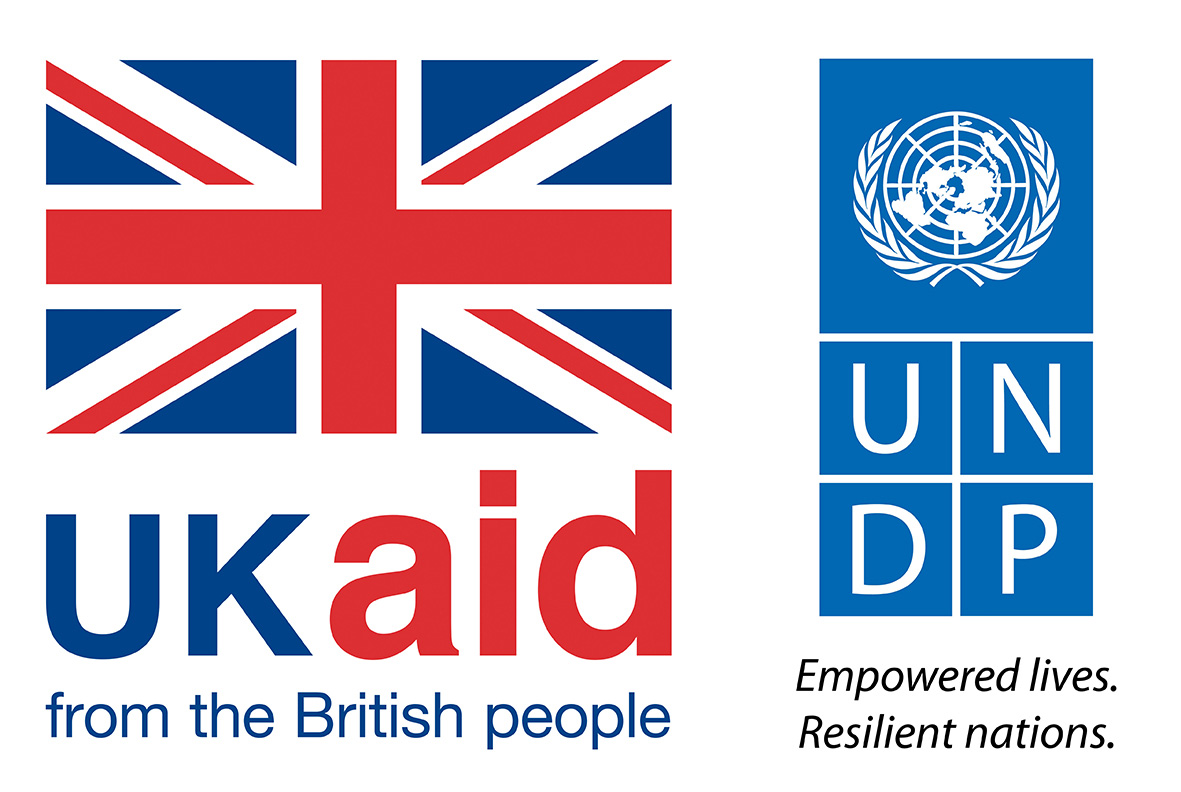
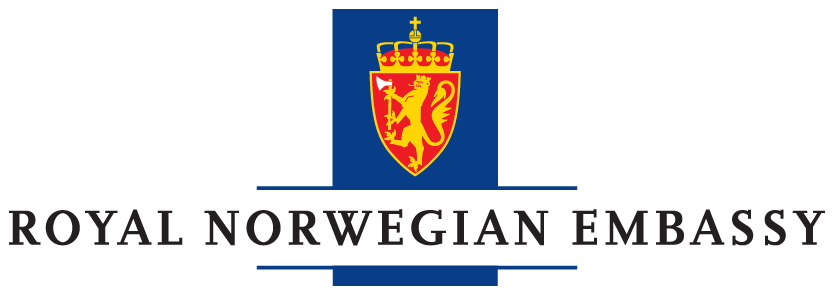
Issue 6, March 2017 - العدد رقم ٦ ، مارس ٢٠١٧
About the bulletin
The Conflict Analysis bulletin, part of the Conflict Analysis Project is an initiative by Lebanon Support, with the support of the United Nations Development Programme (UNDP), available on the Civil Society Knowledge Centre (CSKC), Lebanon Support’s knowledge platform. The Conflict Analysis Project aims to make available and accessible information and research about conflicts in Lebanon, in order to better understand their underlying causes, and inform interventions and policy-making.
This bulletin features visuals focusing on conflict trends mapped during the last third of 2016. It also highlights a selection of the latest publications on the project’s page, including papers, articles, reports, visuals, and interactive content.
Defining Conflict
Going beyond the view of conflict through a security framework associated with belligerency and violence, Lebanon Support upholds that conflict is of a socio-political nature. It thus sheds light on dynamics underlying a broad spectrum of violent and non-violent contentions including social movements, conflicts opposing minorities (ethnic, religious or sexual among others) as well as local, national or regional actors’ policies. Read more and check the interactive conflict map here.
1. Overview of conflict incidents mapped from January to December 2016

In total, there have been 4,605 incidents mapped in 2016, as compared to the 3,502 incidents mapped in 2015. This increase in incidents can be attributed to both greater consistency in Lebanon Support’s mapping of incidents, as the Geolocated Mapping of Conflicts in Lebanon has grown over time, and greater reporting by law enforcement officials regarding their activities and the general security situation in the country.
Over the period of 2016, Lebanon Support detected recurring trends in the mapped data:
- Brawls/disputes were a recurring category in many coded incidents over 2016 and it became increasingly noticeable that such incidents should not be dismissed as minor conflicts. In 73% of cases, brawls/disputes coded in our system developed into a shooting incident, with nearly half of these resulting in injury or death.
- Fluctuations in the reported number of raids and arrests/detentions often coincided with sudden increases in LAF operations which occur in the wake of major national events that threaten national security, such as the el-Qaa bombings.
- In 2016, there was an increasing trend in non-violent collective actions [inc. protests, solidarity movements...]. Of the 463 collective actions, only 3 resulted in 1 or more injuries. This is a positive development from 2015 which saw less collective actions (310 incidents) but a higher concentration of injuries and/or violence, totalling 27 casualties from 6 separate incidents.
- Throughout 2016, we saw a significant decline in policy conflicts in the latter half of the year compared to the January-June period. In fact, while there were 93 incidents coded as policy conflicts in January-June, there were only 59 policy conflicts mapped in July-December.
Taking a look at 2016, it is important to note that July and August saw particularly high numbers of coded incidents in the year. In July, 215 out of 532 total incidents,were categorised as arrests/detentions, while in August, 254 out of 598 incidents were coded as such, which makes the total amount of arrests/detentions amount to 469 in these 2 months alone. Of these 469 arrests, 174 incidents were also categorised as illicit trade/trafficking/smuggling, usually related to drug use and possession of illegal substances. This is particularly significant taking into account that the average number of arrests mapped in the other 10 months of 2016 had only amounted to approximately 90 arrests/detentions per month, 55 of these incidents also having the secondary category of illicit trade.
Focusing on the locations where the most incidents occurred in 2016, the top 5 districts (cazas) were Beirut (with 818 incidents), Baalbek (699 incidents), Sour (405 incidents), Saida (285 incidents) and Tripoli (213 incidents). It is important to note that the nature of these conflicts varied depending on their location. For example, while Beirut witnessed 534 Individual Acts of Violence, 134 Policy Conflicts, 73 Power & Governance Conflicts, 38 Border Conflicts (Israeli border), 20 Border Conflicts (Syrian border), 12 Conflicts of Socio-economic Development, and 7 Conflicts of Social Discrimination (all primary classifications), in Baalbek, classifications of conflict were dispersed with less discrepancy among the types of conflict with 249 Individual Acts of Violence, 210 Power & Governance Conflicts, 149 Border Conflicts (Syrian border), 72 Border Conflicts (Israeli border), 13 Policy Conflicts, and 6 Conflicts of Social Discrimination. Notably however, there were no Conflicts of Socio-economic Development mapped in Baalbek. This disparity in classifications between the two districts reveals that while Beirut faces greater conflict related to social and legal issues, such as socio-economic grievances, discrimination and policy, Baalbek faces greater Power & Governance conflict that often relates to border insecurity (Israeli and Syrian), as well as greater armed violence by transnational groups, armed militants, family groups and individuals who directly defy state authority. For a more in-depth analysis of conflict in the Baalbek region, see the Arsal timeline here and the Ras Baalbek timeline here.
2. Frequency of incidents by primary classification of conflict (from January to December 2016)
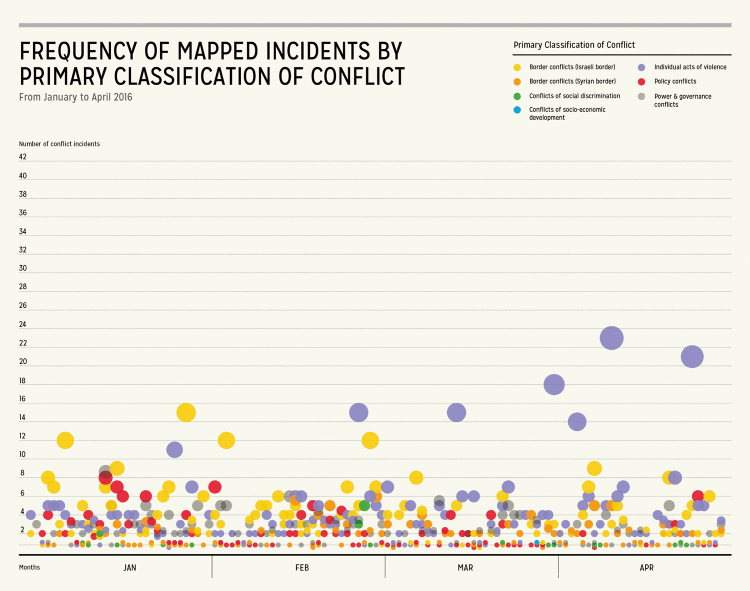
The most frequently mapped primary classification of incidents in 2016 were Individual Acts of Violence with 1,884 incidents mapped as such in the primary classification. Corresponding with the peak in incidents, specifically arrests/detentions, mapped in the months of July and August (see above), the frequency of incidents classified as Individual Acts of Violence as the primary classification witnessed an all time high with 42 Individuals Acts of Violence occurring July 27th. Analysing this surge, a high number of incidents can be traced to Beirut where thirty five arrests/detentions occurred following a large scale police operation pursuing wanted offenders and enforcing vehicle and traffic related infringements. Similarly, in the months of September, November and December, surges coincided with patrols in the region resulting in a large number of arrests/detentions that classified as Individual Acts of Violence.
The second most frequently coded classification were Border Conflicts (Israeli Border) with 1,190 recorded incidents throughout 2016. Border Conflicts as they relate to Israel are consistently recorded throughout the year, however surges, such as that which occurred on July 23rd, are often caused by air space violations by the Israeli Military over multiple locations in Lebanon. Each location that a drone or plane breaches is recorded as a separate incident and thus, seventeen air space violation incidents in one day can occur as it did on the 23rd.
Power and Governance Conflicts were mapped 646 times in 2016, across all regions of the state. While there were a few minor surges in this category, none were noted as outliers. Power and Governance Conflicts are our most consistent classification, with incidents being coded regularly and with no particular concentration of governorate or caza.
The fourth most frequented classification in 2016 were Border Conflicts (Syrian Border), reaching 453 incidents. For this primary classification, there was a surge on the 28th June with 18 separate incidents immediately following the el-Qaa bombings. Seven of these incidents were categorised as raid, 6 as arrest/detention, 4 as military/security forces deployment, and 1 as dismantlement of explosives/demining. These raids, arrests/detentions, military/ security forces deployment can be attributed to a widespread Lebanese Army operation targeting Syrian refugee encampments in Eastern Lebanon, particularly in the Marjayoun and Baalbek regions on 28th June 28th and the days that followed. For example, in one such recorded incident, a Lebanese Army patrol led to the arrest of one hundred and twenty four Syrians on the charge of entering illegally in the refugee camp of Bebnine. (For more on Syrian refugees, refer to our reports on the impact of Lebanon’s policies on Syrian refugees daily lives - entry residency, livelihoods, access to healthcare - and the policy brief based on research findings.)
Policy Conflicts had a similar number of incidents as Syrian-related border conflicts, totalling 391 in the 2016 calendar year. As can be seen in the visual, incidents in this category surged on October 31st with civilians across the country rallying in support of President Aoun’s election. These celebratory collective actions took place in Jbail, Zahle, Saqi Ain el Hadath, Aalmane el-Chouf, Hermel, Batroun, Minyara, Achrafieh, Ras el Metn, Maryjayoun, Majdel el-Koura, and Majdel Akkar. Other Policy Conflicts in 2016 surrounded issues regarding public transportation, the waste management crises, government accountability and transparency, and changes in UNRWA services and aid to Palestinian refugees/civilians, among others.
Conflicts of Social Discrimination were coded 45 times in 2016, the second least frequented category. On the 27th and 28th of February, there were eight recorded Conflicts of Social Discrimination, a high for the 2016 period, though it is important to note here that such Conflicts of Social Discrimination are often coded as a secondary classification in accordance with Lebanon Support’s methodology (read more about this methodology in the below section). Even so, this surge coincided with the collective actions of Hezbollah supporters who blocked off Choueifat - Kfarchima road in protest against an MBC skit that mocked Hezbollah Chief, Sayyed Hassan Nasrallah.
Finally, the least frequented coded classification was Conflict of Socio-Economic Discrimination, which in 2016 totalled 18 mapped incidents. Similar to the above, the week between the 20th and 29th of July was the most concentrated period for this classification, with eight separate incidents mapped for the short time frame. All such incidents relate to contract workers staging collective actions against their employer, Electricité du Liban (EDL), in the districts of Beirut, Sour and Sidon. To read more on the EDL conflict, refer to our timeline.
3. 2016 A year of conflict in review: Total number of incidents mapped in 2016 with top 3 primary and secondary categories
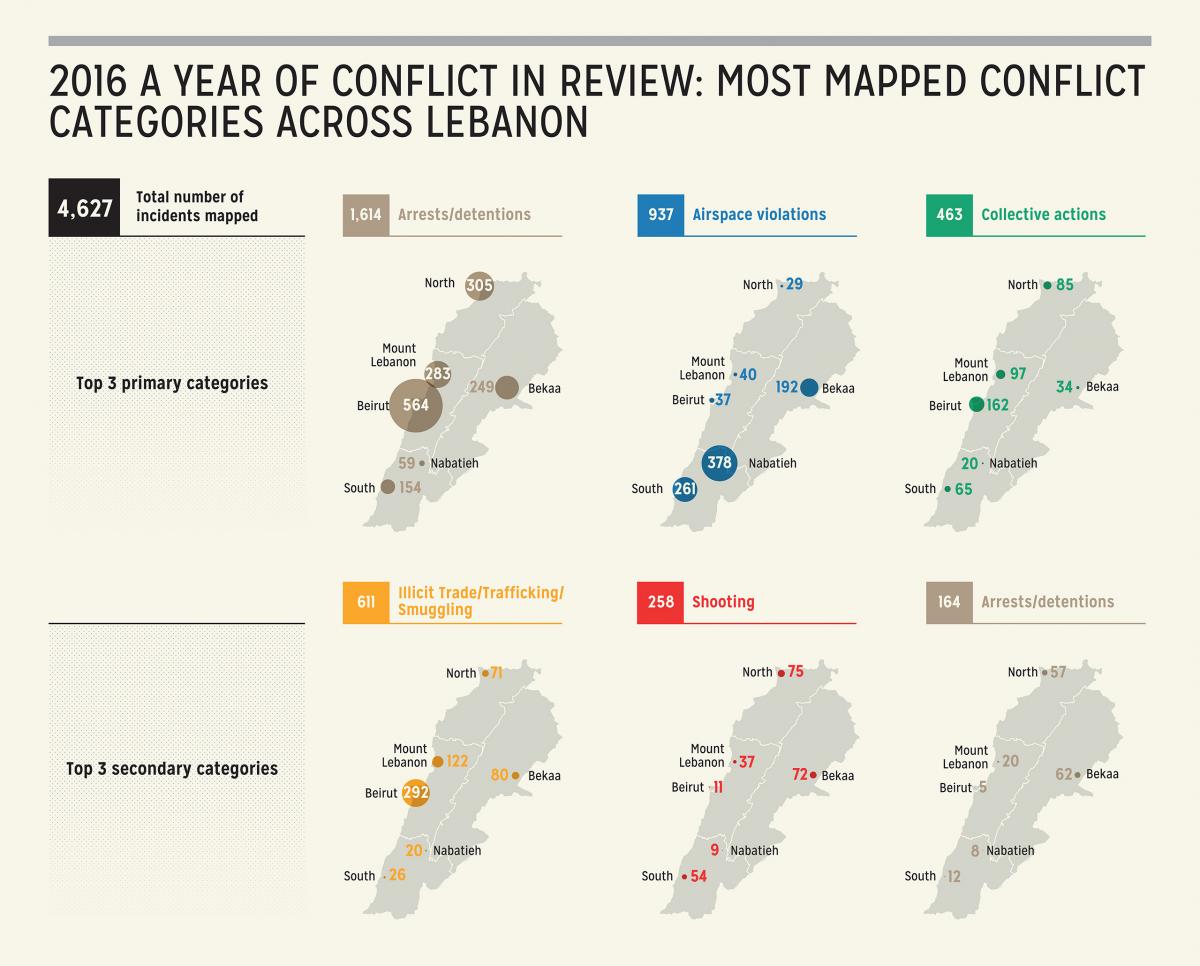
The visual of the Most Mapped Conflict Categories Across Lebanon highlights both the Top 3 primary and Top 3 secondary categories mapped in 2016. All conflict incidents mapped onto our Geolocated Mapping of Conflicts in Lebanon are able to take on a primary and secondary category and classification (read more about our classifications here) depending on the incident’s complexity and depending on Lebanon Support’s methodology of coding.
In total there are 31 socio-political conflict categories in Lebanon Support’s coding system, among these arm storage/smuggling, airstrike, assault, clashes/armed conflict, military/security forces deployment, heavy artillery [including rocket attacks], raid, robbery/trespassing,sea-border crossing/violation, and shooting. When an incident takes on more than one category, it is because more than one type of conflict occurred within the incident. For example, when there is a dispute between individuals that devolves into a shooting, the incident then takes on the primary category of brawl/ dispute and secondary category shooting. In this case, the incident’s categories are determined by chronological order. In other cases, the impact, immensity, and occurrence of a specific category allows that category to outweigh the chronological order of an incident via a weighting system. For example, by rule of the weighting system, a category such as collective action [inc. protests, solidarity movements...] is always a primary category due to the socio-political implications and impact collective actions such as protests, sit-ins, and strikes have on Lebanese society. To be more specific, when there is a protest revolving around the waste management crisis during which security forces are deployed, the incident is coded as collective action [inc. protests, solidarity movements...] for primary category and Military/Security Forces Deployment for the secondary category. Here, the incident’s categories are determined by Lebanon Support’s own weighting system.
In the above visual, of the 4,627 incidents mapped in 2016, almost two thirds of the incidents (3,014 incidents) are primary categorised as either an arrest/detention (1,614), air space violation (937), or collective action [inc. protests, solidarity movements...](463). While the Beirut district exhibits the greatest concentration of arrests and collective actions, it is important to note that conflict incidents are dispersed across Lebanon. Taking into consideration secondary category, there are 148 more illicit trade incidents, often coded with arrest in the primary category, than collective actions.
In 2015, Lebanon Support’s mapping of conflict incidents revealed air space violations (1,162 incidents), arrest/detention (779), collective action [inc. protests, solidarity movements...] (295), shooting (188), raid (168) and heavy artillery (165) as the top 6 mapped primary categories of the year. To summarise, the top 6 primary mapped categories of 2016 were arrest/detention (1,614 incidents), air space violations (937), collective action (463), raid (279), brawl/dispute (247) and heavy artillery (176). This year’s mapping of coded incidents compared to the mapping in 2015 reveals that the category of shooting fell out of the top 6 primary mapped categories and was replaced by brawl/dispute. Comparing the two years, the category of raid has seen the greatest jump in incidents with a 66% increase, while the only category to see a decrease was air space violations, down approximately 19% since last year.
Looking closer into incidents categorised under raid, the 66% increase compared to 2015 in this category does not come as a surprise; in response to the el-Qaa bombings in late June, the state responded by increasing raids across the country targeting terrorist activity (see visual focusing on el-Qaa’s bombings below). The state’s crackdown on Syrian refugees within the country, as well as on Lebanese and other civilians suspected of links to a terrorist organisation led to 42 raids in the month of July and 32 raids in the month of August. Combined, raids mapped in June and July amounted to over a quarter of the total amount of raids recorded in 2016. Of these 74 incidents, 36 were classified in the primary or secondary classification as Border Conflict (Syrian Border), 29 of these also classified as Conflicts of Social Discrimination, which indicates that many of the raids conducted at Syrian refugee encampments are discriminatory in nature. However, it is also important to note that of the 74 raids in June and July, 21 raids were also classified as Power & Governance in the primary or secondary classification. These incidents are often linked to suspected or confirmed terrorist activity. Furthermore, of the 279 raids (primary category) mapped, 218 were carried out by the Lebanese Armed Forces (LAF) (including military intelligence), 51 by the Internal Security Forces (ISF) (also including ISF intelligence), 6 by General Security, 2 by Lebanese Customs, and 2 by State Security.
4. Focus on: A year in review
The following three visuals titled “Most Mapped Actors & Corresponding Types of Conflict,” “Focus on the El Qaa Bombings” and “Focus on Mapped Collective Actions” were featured in Lebanon Support’s three Conflict Analysis Bulletins of 2016 as “Focus on” conflict trends or events. A brief description of each visual is found below and are discussed in greater depth in their respective bulletins.
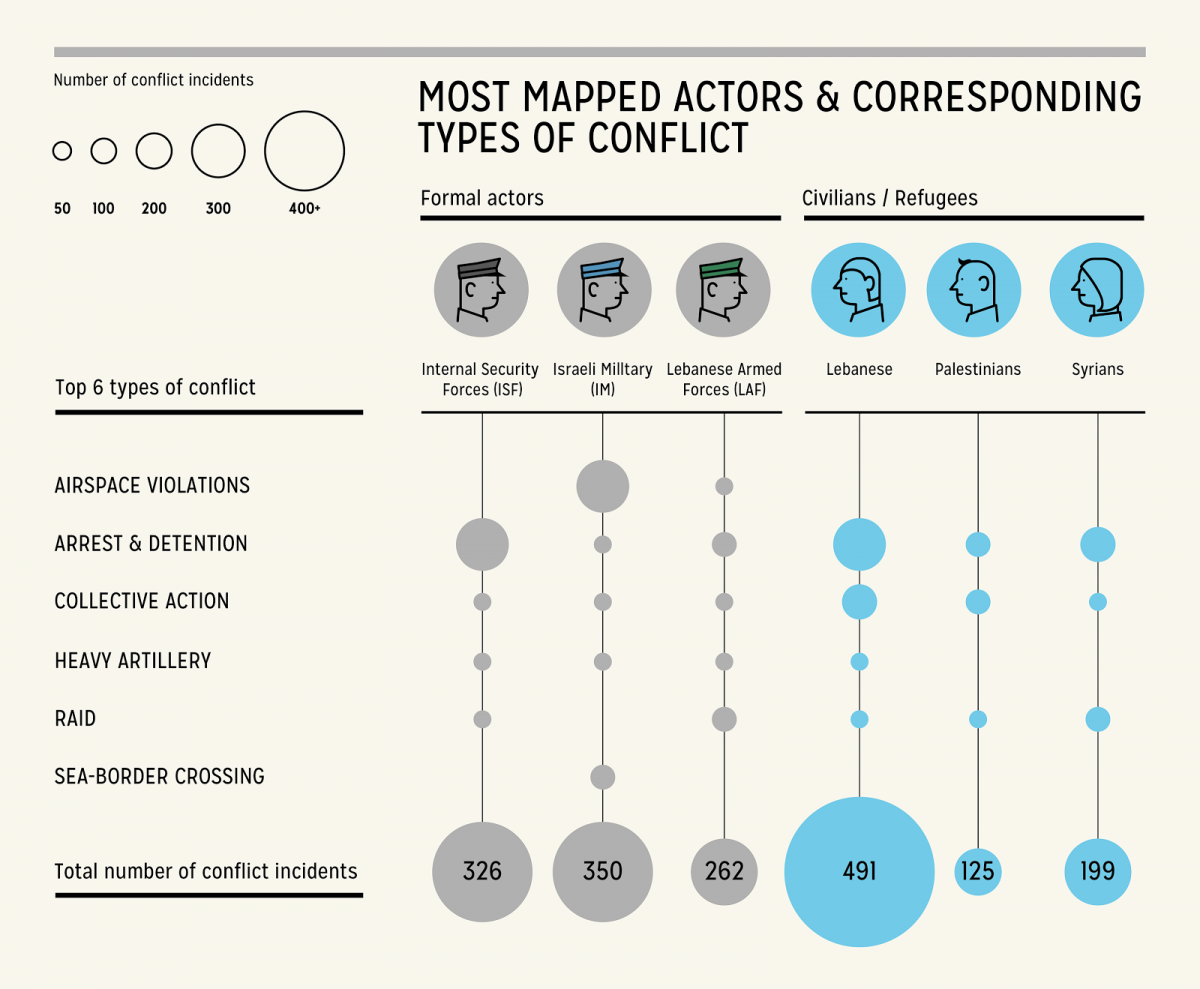
Featured in the third issue of Lebanon Support’s Conflict Analysis Bulletin, the above visual focuses on the top 6 mapped actors in conflict incidents and highlights their involvement in the top 6 corresponding categories of conflict in the months of January- April 2016. Furthermore, the visual highlights the activity levels of both formal actors and civilians/ refugees. Read more on this here.

Featured in Lebanon Support’s fourth Conflict Analysis Bulletin, the above visual tracks the happenings of the el-Qaa bombings that took place on June 27th, 2016. The visual also notes the Lebanese state’s response to the bombings through raid operations carried out and curfews imposed on Syrian refugees residing in the el-Qaa and Ras Baalbek area. Read more on this here and to read more on the ongoing Ras Baalbek clashes, see our timeline.
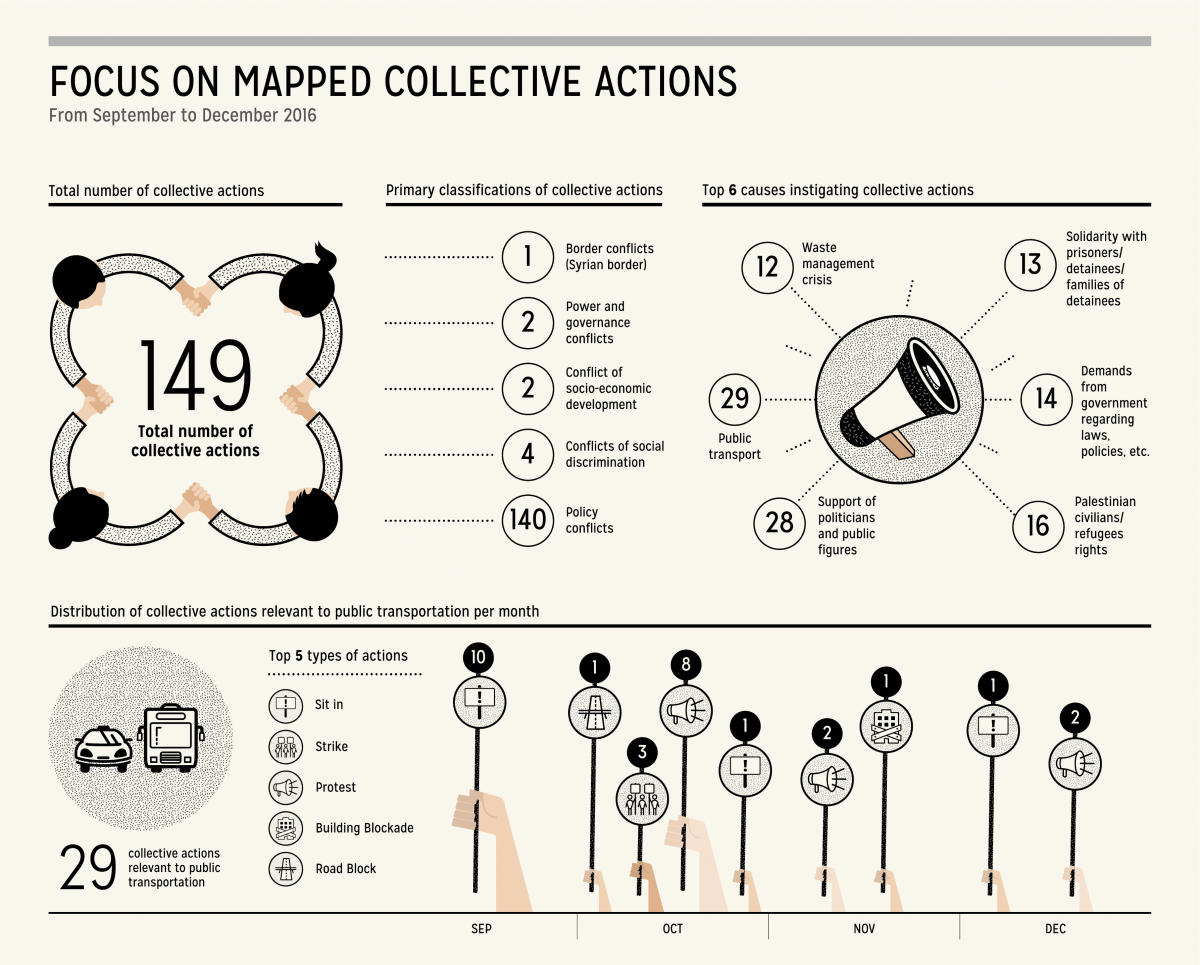
Featured in Lebanon Support’s fifth Conflict Analysis Bulletin published in January 2017, this last focus on visual zoomed in on mapped collective actions in the final third of 2016. The bulletin particularly highlights the top 6 causes that instigated collective actions in September-December. Read more on this here.
عن النشرة
إنّ نشرة تحليل النزاعات، وهي جزء من مشروع تحليل النزاعات (Conflict Analysis Project)، هي عبارة عن مبادرة أطلقها مركز دعم لبنان بدعم من برنامج الأمم المتحدة الإنمائي ووضعها على منصة المعرفة خاصّته، أي بوابة المعرفة للمجتمع المدني. تهدف هذه النشرة إلى إتاحة المعلومات والبحوث حول النزاعات في لبنان بغية تحسين فهم أسبابها الكامنة والتأثير في عملية بلورة التدخلات ووضع السياسات. وتتضمّن هذه النشرة موادا بصرية تُركِّز على اتجاهات النزاعات الممسوحة خلال ثاني أربع أشهر من السنة. كما أنها تسلط الضوء على مروحة منتقاة من أحدث المطبوعات والمنشورات على صفحة مشروع تحليل النزاعات، بما في ذلك الأوراق، والمقالات، والتقارير، والمواد البصرية، والمحتوى التفاعلي.
تعريف النزاع
لا ينظر مركز دعم لبنان إلى العنف من منظور إطار أمني تصاحبه أعمال العنف والعدوانية، بل يتعداه ليتمسّك بموقفه القائل إنّ النزاع هو ذات طبيعة اجتماعية وسياسية. وبالتالي، يضيء المركز على الديناميات التي تحيط بمروحة واسعة من الخلافات العنيفة وغير العنيفة، بما فيها الحركات الإجتماعية مروراً بالنزاعات التي تتورّط فيها الأقليات (الإثنية أو الدينية أو الجنسية من ضمن أخرى)، بالإضافة إلى سياسات الأطراف الفاعلة المحلية أو الوطنية أو الإقليمية. إقرأ المزيد وتصفّح خريطة النزاعات التفاعلية هنا.
1. لمحةٌ عامةٌ عن الحوادث المتصلة بالنزاعات والممسوحة من كانون الثاني/يناير إلى كانون الأول/ديسمبر 2016
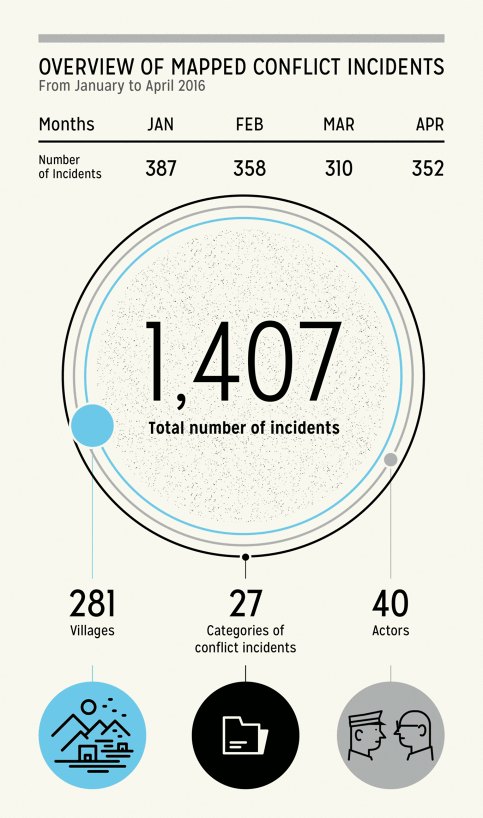
بالإجمال، هنالك 4605 حادثاً ممسوحاً في العام 2016، مقارنةً بـ3502 حادثاً ممسوحاً في العام 2015. يمكن نسب هذه الزيادة إلى الاتساق الأكبر في مسح مركز دعم لبنان للحوادث، حيث تنامت خريطة المواضع الجغرافية للنزاعات في لبنان مع الزمن، وتزايد وضع التقارير من قبل مسؤولي إنفاذ القانون بالنظر إلى أنشطتهم ووضع الأمن العام في البلد.
على مدى العام 2016، كشف مركز دعم لبنان ميولاً متكررة في البيانات الممسوحة:
- كانت فئة المشاجرات/الخلافات فئةً متكررةً في كثيرٍ من الحوادث المشفرة على مدى العام 2016 وبات جديراً بالملاحظة على نحوٍ متزايد أنّ مثل هذه الحوادث يجب ألّا تُهمل بوصفها نزاعاتٍ صغرى. ففي 73 بالمئة من الحالات، تطوّرت فئة المشاجرات/الخلافات المشفرة في نظامنا إلى حادث إطلاق نار، وأدّى قرابة نصفها إلى الإصابة أو الوفاة.
- غالباً ما تزامنت التقلّبات في الأعداد المذكورة في فئتي المداهمات والتوقيفات/الاحتجازات مع الزيادات المفاجئة في عمليات الجيش اللبناني التي حدثت في أعقاب الأحداث الوطنية الكبيرة التي هدّدت الأمن الوطني، مثل تفجيرات القاع.
- في العام 2016، كان هنالك ميلٌ متزايدٌ في التحرّكات الشعبية غير العنفية [احتجاجات محدودة، حركات تضامن...]. ومن أصل 463 تحرّكاً شعبياً، أفضى ثلاثة منها إلى إصابةٍ أو أكثر. وهذا تطوّرٌ إيجابي مقارنةً بالعام 2015 الذي شهد تحركاتٍ شعبيةً أقلّ عدداً (310 حوادث) ولكن أكثر كثافةً في الإصابات و/أو العنف، ما مجموعه 27 إصابة من 6 حوادث منفصلة.
- شهدنا طيلة العام 2016 انخفاضاً ملموساً في النزاعات السياسية في النصف الأخير من العام مقارنةً بالفترة الممتدة بين شهري كانون الثاني/يناير وحزيران/يونيو. في الواقع، جرى تشفير 93 حادثاً بوصفها نزاعاتٍ سياسية في الفترة عينها، في حين جرى مسح 59 حادث نزاع سياسي فقط بين شهري تموز/يوليو وكانون الأول/ ديسمبر.
بإلقاء نظرةٍ على العام 2016، من الأهمية بمكان ملاحظة أنّ شهري تموز/يوليو وآب/أغسطس شهدا على وجه الخصوص الأعداد الأكبر من الحوادث المشفرة في هذا العام. في شهر تموز/يوليو، صُنّف 215 حادثاً من أصل 532 حادثاً في فئة التوقيفات/الاحتجازات، بينما كان العدد في آب/أغسطس254 من أصل 598 حادثاً، ما يجعل العدد الكلي لهذه الحوادث 469 حادثاً في هذين الشهرين فحسب. ومن بين 469 حادث توقيف، هنالك 174 حادثاً صُنّف في فئات التجارة غير المشروعة/الإتجار غير المشروع/التهريب، وهي تتعلّق عادةً بتعاطي المخدرات وحيازة مواد ممنوعة. ومن المهم أن نأخذ بالحسبان أنّ العدد المتوسط للتوقيفات الممسوحة في الشهور العشرة الأخرى من العام 2016 بلغ قرابة 90 حادث توقيف/احتجاز شهرياً، منها 55 حادثاً تندرج أيضاً في التصنيف الثانوي للتجارة غير المشروعة.
وبالإضاءة على المواضع التي حدثت فيها غالبية حوادث العام 2016، كان في المقدمة المناطق (الأقضية) الخمسة التالية: بيروت (818 حادثاً)، بعلبك (699)، صور (405)، صيدا (285)، طرابلس (213). من الأهمية بمكان ملاحظة أنّ طبيعة هذه النزاعات تنوّعت وفق موضعها. فعلى سبيل المثال، شهدت بيروت 534 حادثاً من حوادث أعمال العنف الفردي، و134 حادث نزاعٍ سياسي، و73 حادثاً من حوادث النزاعات على السلطة والحكم، و38 حادثاً من حوادث النزاعات الحدودية (الحدود الإسرائيلية)، و20 حادثاً من حوادث النزاعات الحدودية (الحدود السورية)، و12 حادثاً من حوادث النزاعات المرتبطة بالتنمية الاجتماعية الاقتصادية، و7 حوادث من النزاعات المرتبطة بالتفرقة الاجتماعية (جميعها من التصنيفات الأولية)، في حين تفرّقت تصنيفات النزاع في بعلبك بتبايناتٍ أقل بين أنواع النزاع مع 249 حادثاً من أعمال العنف الفردي، و210 من النزاعات على السلطة والحكم، و149 من النزاعات الحدودية (الحدود السورية)، و72 من النزاعات الحدودية (الحدود الإسرائيلية)، و13 من النزاعات السياسية، و6 من النزاعات المرتبطة بالتفرقة الاجتماعية. لكنّ اللافت في الأمر هو عدم وجود نزاعاتٍ مرتبطة بالتنمية الاجتماعية الاقتصادية في بعلبك. يكشف هذا التباين في التصنيفات بين المنطقتين أنّه في حين تواجه بيروت نزاعاً أكبر فيما يتعلق بالقضايا الاجتماعية والقانونية من قبيل المظالم الاجتماعية الاقتصادية والتفرقة والسياسة، فإنّ بعلبك تواجه نزاعاً أكبر على السلطة والحكم، غالباً ما يتعلق بانعدام أمن الحدود (الإسرائيلية والسورية)، وكذلك عنفاً مسلحاً أكبر من قبل المجموعات العابرة للحدود والميليشيات المسلحة والأفراد والمجموعات العائلية التي تتحدّى سلطة الدولة. للاطلاع على مزيدٍ من التحليل المعمّق للنزاع في منطقة بعلبك، انظر الجدول الزمني لعرسال هنا والجدول الزمني لرأس بعلبك هنا.
2. تواتر النزاعات بحسب التصنيف الأولي للنزاعات (من كانون الثاني/يناير إلى كانون الأول/ديسمبر 2016)

كانت أعمال العنف الفردية هي التصنيف الأولي الأكثر تواتراً للحوادث الممسوحة في العام 2016 بـ1884 حادثاً ممسوحاً بوصفها كذلك في التصنيف الأولي. تتوافق هذه الحوادث مع الذروة في الحوادث، لاسيما التوقيفات/الاحتجازات، الممسوحة في شهري تموز/يوليو وآب/أغسطس (انظر أعلاه)، حيث شهد تواتر الحوادث المصنفة كأعمال عنفٍ فردية بوصفها تصنيفاً أولياً ارتفاعاً قياسياً بـ42 حادثاً من حوادث أعمال العنف الفردية التي جرت بتاريخ 27 تموز/يوليو. وبتحليل هذا الصعود، يمكن عزو العدد الكبير من الحوادث إلى بيروت حيث جرى 35 حادث توقيف/احتجاز بعد عمليةٍ واسعة النطاق قامت بها الشرطة لملاحقة الجناة المطلوبين وفرض تطبيق المخالفات المتعلقة بالمركبات والمرور. وعلى نحوٍ مشابه، تزامنت الارتفاعات في أشهر أيلول/سبتمبر وتشرين الثاني/نوفمبر وكانون الأول/ديسمبر مع انتشار الدوريات في المنطقة، ما أسفر عن عددٍ كبيرٍ من التوقيفات/الاحتجازات المصنّفة في فئة أعمال العنف الفردية.
أمّا المرتبة الثانية للتصنيفات المشفّرة الأكثر تواتراً، فقد شغلتها فئة النزاعات الحدودية (الحدود الإسرائيلية) بـ1190 حادثاً مسجلاً طيلة العام 2016. وقد سُجّلت النزاعات الحدودية المتعلقة بإسرائيل باتساق طيلة العام، لكنّ السبب في ارتفاع أعدادها، مثلما حدث بتاريخ 23 تموز/يوليو، يعود إلى انتهاكات المجال الجوي من قبل الجيش الإسرائيلي في مواضع متعددة في لبنان. وسُجّل كل موضعٍ خرقته طائرة أو طائرة من دون طيار بوصفه حادثاً مستقلاً، وبالتالي يمكن ظهور 17 حادثاً من انتهاكات المجال الجوي في يومٍ واحد كما حصل بتاريخ 23 - 7 -2016.
كذلك، مُسحت النزاعات على السلطة والحكم 646 مرةً في العام 2016 في كافّة أرجاء مناطق الدولة. وفي حين ظهر قليلٌ من الارتفاعات الطفيفة في هذه الفئة، إلا أنّ أياً منها لم يُلحظ بوصفه شذوذاً. والنزاعات على السلطة والحكم هي التصنيف الأكثر اتساقاً من بين تصنيفاتنا، بحوادث شُفّرت بانتظامٍ من دون تركّزٍ في محافظةٍ أو قضاء.
تشغل النزاعات الحدودية (الحدود السورية) المرتبة الرابعة في التصنيفات الأكثر تواتراً في العام 2016، حيث بلغ عددها 453 حادثاً. بالنسبة إلى هذا التصنيف الأوّلي، كان هنالك ارتفاعٌ بتاريخ 28 تموز/يوليو بـ18 حادثاً منفصلاً أعقبت تفجيرات القاع مباشرةً. وقد صُنّف 7 حوادث منها كمداهمات، و6 كتوقيفات/احتجازات، و4 كنشر قوات أمنية/عسكرية، و1 كتفكيك متفجرات/مفخّخات. يمكن أن تُعزى هذه المداهمات والتوقيفات/الاحتجازات ونشر قوات أمنية/عسكرية إلى عمليةٍ واسعة النطاق قام بها الجيش اللبناني واستهدفت مخيمات اللاجئين السوريين شرق لبنان، لاسيما في منطقتي مرجعيون وبعلبك في 28 حزيران/يونيو والأيام التي أعقبته. ففي إحدى الحوادث المسجلة، على سبيل المثال، ألقت دورية للجيش اللبناني القبض على 124 سورياً بتهمة الدخول غير الشرعي في مخيم ببنين للاجئين. (للمزيد حول اللاجئين السوريين، راجع تقاريرنا المتعلقة بتأثير السياسات اللبنانية على حياة اللاجئين السوريين اليومية ـ الدخول والإقامة، سبل العيش، الحصول على الرعاية الصحية ـ وموجز السياسات القائم على نتائج بحثية).
كان عدد حوادث النزاعات السياسية مشابهاً لعدد حوادث النزاعات الحدودية المتعلقة بسوريا، بمجموع 391 حادثاً في تقويم العام 2016. وكما يظهر في المادة البصرية، ارتفعت الحوادث في هذه الفئة بتاريخ 31 تشرين الأول/أكتوبر مع تحشدات المدنيين في أرجاء البلد تأييداً لانتخاب الرئيس عون. جرت هذه التحركات الشعبية الاحتفالية في جبيل وزحلة وسقي عين الحدث وعلمان الشوف والهرمل والبترون والمنيارة والأشرفية ورأس المتن ومرجعيون ومجدل الكورة ومجدل عكار. تشمل النزاعات السياسية الأخرى في العام 2016 قضايا تتعلق بالنقل العام وأزمة إدارة النفايات ومحاسبة الحكومة والشفافية، والتغيّرات في خدمات الأونروا والمساعدات المقدّمة للفلسطينيين اللاجئين/المدنيين، من بين نزاعاتٍ أخرى.
كما أنّ النزاعات المرتبطة بالتفرقة الاجتماعية شُفّرت 45 مرةً في العام 2016، وشغلت المرتبة الثانية في الفئة الأقل تكراراً. في يومي 27 و28 شباط/فبراير، سُجّلت 8 حوادث من النزاعات المرتبطة بالتفرقة الاجتماعية، وهي الأعلى في العام 2016، على الرغم من أهمية أن نلاحظ هنا أنّ مثل هذه النزاعات المرتبطة بالتفرقة الاجتماعية تُشفّر في كثيرٍ من الأحيان بوصفها تصنيفاً ثانوياً وفق منهجية البحث الخاصة بمركز دعم لبنان (اقرأ المزيد حول هذه المنهجية في القسم أدناه). وعلى الرغم من ذلك، تزامن هذا الارتفاع مع التحركات الشعبية لمؤيّدي حزب الله الذين أغلقوا طريق الشويفات ـ كفر شيما احتجاجاً على مشهدٍ هزلي يسخر من زعيم حزب الله السيد حسن نصر الله،عرضه تلفزيون إم بي سي MBC.
أخيراً، كانت النزاعات المرتبطة بالتفرقة الاجتماعية الاقتصادية هي التصنيف المشفّر الأقل تواتراً، حيث بلغ مجموع حوادثه الممسوحة 18 حادثاً. وعلى نحوٍ مشابهٍ لما ذُكر آنفاً، كان الأسبوع الممتد بين 20 و29 تموز/يوليو هو الفترة الأشد تركّزاً لهذا التصنيف، بـ8 حوادث ممسوحة لهذا الإطار الزمني الوجيز. تتعلّق كافّة هذه الحوادث بتجمّع العمال المتعاقدين في تحركاتٍ شعبيةٍ ضدّ أرباب عملهم، شركة كهرباء لبنان، في مناطق بيروت وصور وصيدا. لقراءة المزيد حول نزاع شركة كهرباء لبنان، راجع الجدول الزمني الخاص بنا.
3. استعراض 2016، سنة من النزاعات: العدد الإجمالي للحوادث الممسوحة في العام 2016 مع الفئات الثلاث الأولية والثانوية الأعلى
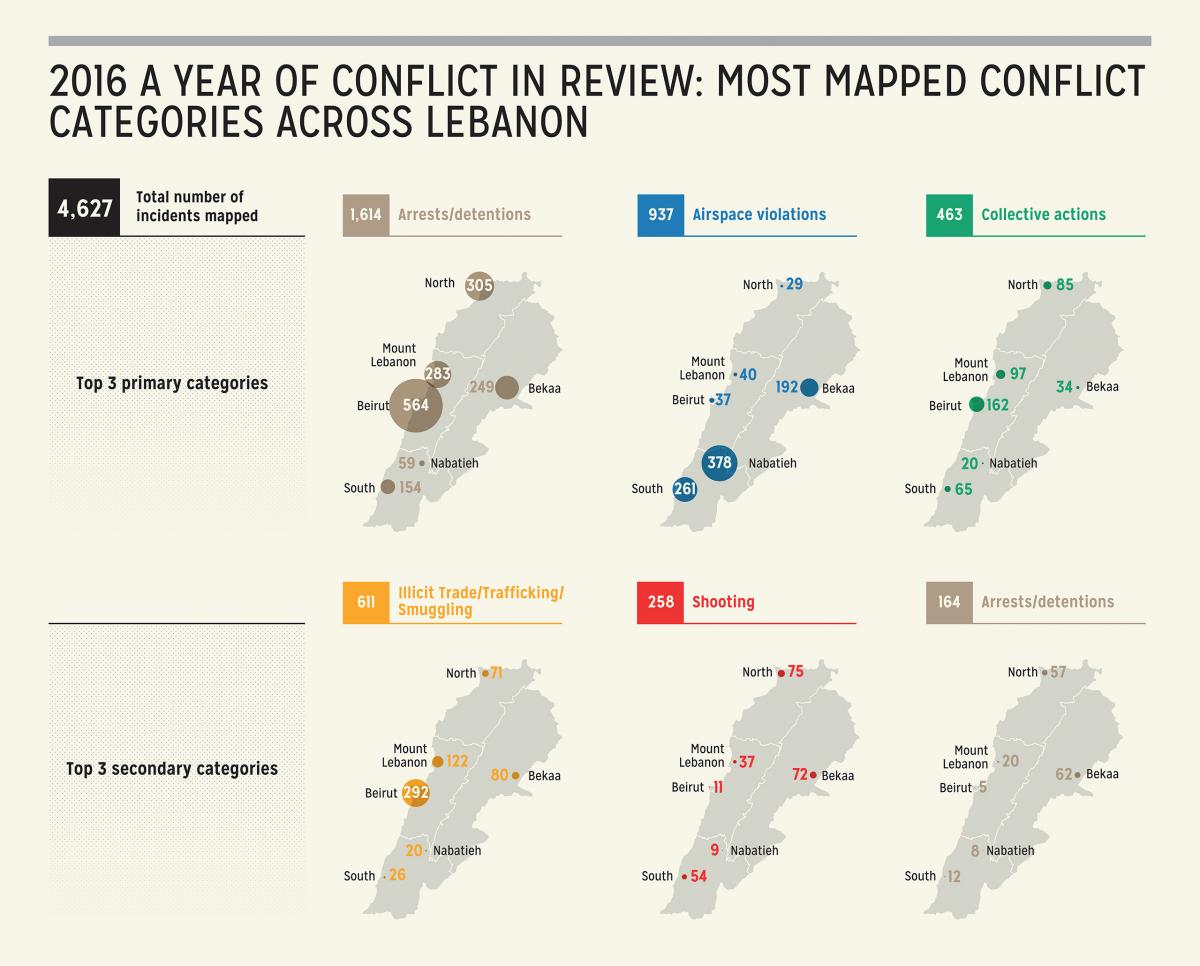
يسلّط هذا الرسم البياني لأكثر فئات النزاع مسحاً في أرجاء لبنان الضوء على الفئات الثلاث الأولية والثانوية الأعلى في العام 2016. كافة حوادث النزاع الممسوحة على خريطة المواضع الجغرافية للنزاعات في لبنان قابلة لأن تتخذ شكل فئات وتصنيفاتٍ أولية وثانوية (اقرأ المزيد حول تصنيفاتنا هنا) اعتماداً على تعقيد الحادث واعتماداً على منهجية التشفير لدى مركز دعم لبنان.
هنالك بالإجمال 31 فئة للنزاع السياسي الاجتماعي في نظام تشفير مركز دعم لبنان، ومن ضمنها تخزين/تهريب السلاح، الضربات الجوية، الاعتداءات، النزاعات/الاشتباكات المسلحة، نشر قوات أمنية/عسكرية، المدفعية الثقيلة [بما في ذلك الهجمات الصاروخية]، المداهمات، السطو/التعدي على ممتلكات الغير، انتهاك/اختراق الحدود البحرية، إطلاق النار. عندما يندرج حادثٌ في أكثر من فئةٍ واحدة، فذلك لأنّ أكثر من نمط نزاعٍ يظهر في الحادث. فعلى سبيل المثال، عند وجود خلافٍ بين أفرادٍ يتحوّل إلى إطلاق نار، يظهر الحادث في الفئة الأولية مشاجرة/خلاف وفي الفئة الثانوية إطلاق نار. في هذه الحالة، يُعيّن الترتيب الزمني فئات الحادث. وفي حالاتٍ أخرى، يسمح تأثير فئة محددة واتساعها وظهورها بتثقيلها الترتيب الزمني لحادثٍ عبر نظام التثقيل. ففئةٌ من قبيل فئة التحركات الشعبية [الاحتجاجات المحدودة، حركات التضامن...]، مثلاً، تكون دائماً بحكم نظام التثقيل فئةً أولية بسبب آثارها الاجتماعية السياسية ولتأثير التحركات الشعبية مثل الاحتجاجات والاعتصامات والإضرابات في المجتمع اللبناني. ولنكون أكثر تحديداً، عندما يوجد احتجاجٌ يتمحور حول أزمة إدارة النفايات وتُنشر قوات الأمن أثناءه، يُشفّر الحادث بوصفه تحركاً شعبياً [احتجاجاً محدوداً، حركة تضامن...] ضمن فئةٍ أولية، وضمن فئةٍ ثانوية بوصفه نشر قواتٍ أمنيةٍ/عسكرية. تُعيّن فئات الحادث هنا بنظام التثقيل الخاص بمركز دعم لبنان.
في المادة البصرية أعلاه، يُصنّف ثُلثا الحوادث تقريباً (3014 حادثاً)، من أصل 4627 حادثاً ممسوحاً في العام 2016، في فئةٍ أولية بوصفها إمّا حوادث توقيف/احتجاز (1614) أو انتهاكاً للمجال الجوي (937) أو تحركاً شعبياً [احتجاجاً محدوداً، حركة تضامن...] (463). وفي حين تعرض منطقة بيروت التركّز الأكبر للتوقيفات والتحركات الشعبية، فمن الأهمية بمكانٍ ملاحظة أنّ حوادث النزاعات مبعثرة في أرجاء لبنان. وإذا أخذنا بالحسبان الفئة الثانوية، هنالك 148 حادث تجارةٍ غير مشروعة، شُفّرت في كثيرٍ من الأحيان مع التوقيف في الفئة الأولية أكثر من تشفيرها في فئة التحركات الشعبية.
في العام 2015، أظهرت خريطة النزاعات الخاصة بمركز دعم لبنان انتهاكات المجال الجوي (1162 حادثاً)، توقيف/احتجاز (779)، تحرك شعبي [احتجاج محدود، حركة تضامن...] (295)، إطلاق نار (188)، مداهمة (168)، مدفعية ثقيلة (165)، بوصفها أعلى ست فئات أولية ممسوحة لذلك العام. وللإيجاز، كانت أعلى ست فئات أولية ممسوحة للعام 2016 كما يلي: توقيف/احتجاز (1614)، انتهاكات المجال الجوي (937)، تحرّك شعبي (463)، مداهمة(279)، مشاجرة/خلاف (247)، مدفعية ثقيلة (176). تُظهر خريطة هذا العام للحوادث المُشفّرة مقارنةٌ بالخريطة في العام 2015 أنّ فئة إطلاق النار سقطت من أعلى ست فئات أولية ممسوحة وحلّت محلّها فئة مشاجرة/خلاف. وبمقارنة العامين، شهدت فئة المداهمة الطفرة الأكبر في الحوادث بزيادةٍ مقدارها 66 بالمئة، في حين أنّ الفئة الوحيدة التي شهدت انخفاضاً هي انتهاكات المجال الجوي، حيث انخفضت بقرابة 19 بالمئة منذ العام الماضي.
وبإلقاء نظرةٍ متفحّصة على الحوادث المدرجة في فئة مداهمة، لم تكن زيادة الـ66 بالمئة في هذه الفئة مقارنةً بالعام 2015 مفاجئةً؛ فاستجابةً لتفجيرات القاع في أواخر حزيران/يونيو، ردّت الدولة بزيادة المداهمات في أرجاء البلد مستهدفةً النشاط الإرهابي (انظر الإضاءة البصرية على تفجيرات القاع أدناه). وقد أدّت حملة الدولة على اللاجئين السوريين داخل البلد، وكذلك على اللبنانيين ومدنيين آخرين مشتبهين بالارتباط بمنظمةٍ إرهابية، إلى 42 مداهمة في شهر تموز/يوليو و32 مداهمة في شهر آب/أغسطس. وإذا دمجنا الأرقام، نجد أنّ عدد المداهمات الممسوحة في شهري حزيران/يونيو وتموز/يوليو وصل إلى أكثر من ربع المجموع الكليّ للمداهمات المسجّلة في العام 2016[U1] . ومن بين الحوادث الـ74، صُنّف 36 منها ضمن التصنيف الأولي أو الثانوي بوصفها نزاعاً حدودياً (الحدود السورية)، وصُنّف 29 منها أيضاً بوصفها نزاعاتٍ مرتبطة بالتفرقة الاجتماعية، ما يشير إلى أنّ كثيراً من المداهمات التي جرت في مخيمات اللاجئين السوريين لها طابع تفريقي. وعلى الرغم من ذلك، من المهم أيضاً ملاحظة أنّه من بين 74 مداهمة في حزيران/يونيو وتموز/يوليو، صُنّفت 21 مداهمة كذلك بوصفها نزاعاً مرتبطاً بالسلطة والحكم ضمن التصنيف الأولي أو الثانوي. رُبطت غالبية هذه الحوادث بنشاطٍ إرهابي مؤكّدٍ أو مشتبهٍ به. علاوةً على ذلك، هنالك من بين الـ279 مداهمة ممسوحة (الفئة الأولية) 218 مداهمة نفّذها الجيش اللبناني (بما في ذلك مخابرات الجيش)، و51 مداهمة نفّذتها قوى الأمن الداخلي (بما في ذلك أيضاً مخابرات قوى الأمن الداخلي)، و6 مداهمات نفّذها الأمن العام، ومداهمتان نفّذهما أمن الدولة واثنتان نفّذتهما الجمارك اللبنانية.
4. إضاءة على: استعراض سنة
ظهرت المواد البصرية الثلاث التالية المعنونة بـ"فاعلي أنماط النزاع الأكثر مسحاً وفئاتهم المطابقة" و"إضاءة على تفجيرات القاع" و"إضاءة على التحركات الشعبية الممسوحة" في نشرات تحليل النزاع الخاصة بمركز دعم لبنان للعام 2016 بوصفها "إضاءةً على" ميول النزاع أو مناسباته. ثمّة وصفٌ بصري موجز لكلّ مادة بصريةٍ أدناه وقد نوقشت بعمقٍ أكبر في النشرات المتعلقة بها.

تركّز المادة البصرية أعلاه والتي ظهرت في العدد الثالث من نشرة تحليل النزاعات الخاصة بمركز دعم لبنان على أعلى ستة فاعلين ممسوحين في حوادث النزاعات وتسلّط الضوء على مشاركتهم في أعلى ست فئات نزاع مطابقة في الأشهر من كانون الثاني/يناير إلى نيسان/أبريل 2016. علاوةً على ذلك، تسلط المادة البصرية الضوء على مستويات نشاط الفاعلين الرسميين والمدنيين/اللاجئين. اقرأ المزيد عن ذلك هنا.

تتتبع المادة البصرية أعلاه والتي ظهرت في العدد الرابع من نشرة تحليل النزاعات الخاصة بمركز دعم لبنان أحداث تفجيرات القاع التي حدثت بتاريخ 27 تموز/يوليو 2016. تشير المادة البصرية أيضاً إلى ردّ الدولة اللبنانية على التفجيرات من خلال عمليات المداهمة وحظر التجول في أماكن إقامة اللاجئين السوريين في منطقة القاع ورأس بعلبك. اقرأ المزيد حول هذا الأمر هنا، ولقراءة المزيد حول اصطدامات رأس بعلبك الجارية، انظر الجدول الزمني الخاص بنا.

هذه الإضاءة الأخيرة لمادةٍ بصرية التي ظهرت في العدد الخامس من نشرة تحليل النزاعات الخاصة بمركز دعم لبنان الصادر في كانون الثاني/يناير 2017 تُكبّر التحركات الشعبية الممسوحة في الثلث الأخير من العام 2016. تسلّط النشرة الضوء بصورةٍ خاصةٍ على أعلى ستة أسباب أثارت التحركات الشعبية بين شهري أيلول/سبتمبر وكانون الأول/ديسمبر. اقرأ المزيد حول هذا الأمر هنا.

